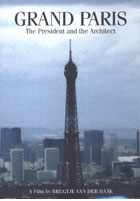
Grand Paris: The President and the Architect 2009
Distributed by Icarus Films, 32 Court St., 21st Floor, Brooklyn, NY 11201; 800-876-1710
Produced by Bregtje Van Der Haak
Directed by Bregtje Van Der Haak
DVD, color, 50 min.
Sr. High - Adult
Architecture, Urban Planning
Date Entered: 10/07/2010
Reviewed by Winifred Fordham Metz, University of North Carolina at Chapel HillMitterand had Grands Travaux, a program of architectural projects in Paris (including the pyramid of the Louvre). Chirac’s projet presidential was the Musée des Arts et Civilisations. What will Sarkozy’s legacy be?
In 2008, French president Nicolas Sarkozy announced his idea of Le Grand Paris. A resolutely ambitious project dreamt up by Sarkozy, Le Grand Paris calls for a sustainable, post-Kyoto ecological city embracing, rather than fighting, nature. The Paris of today is largely unchanged from Haussmann’s Paris. Home to a little more than 2 million people and contained by the famous Boulevard Peripherique (or Paris Ring road), the city is experiencing a severe housing crisis and suffers from poor public transport. Just on the other side of the Peripherique, lie a multitude of Banlieues (suburbs) housing an estimated 10 million people. A history of tension between the city and the Banlieues exists. With Grand Paris, Sarkozy intends to blend these two distinct worlds into one large modern metropolis – achieving progress, prosperity and more equality for all of its inhabitants. Acknowledging this to be the biggest challenge for 21st century politics, he enlists a cadre of 10 renowned architects to present plans for Le Grand Paris (Mike Davies, Yves Lion, Djamel Klouche, Christian de Portzamparc, Antoine Grumbach, Jean Nouvel, Paola Vigano and Bernardo Secchi, Finn Geipel, Roland Castro and Winy Maas).
Here, filmmaker Bregtje Van Der Haak follows Dutch architect Winy Maas over the course of a year from his initial meeting with Sarkozy to the public presentation of the proposals. Working with other architects in his firm in Rotterdam as well as with colleagues in France, Maas diligently traverses the city streets and Banlieues to get perspective on the project, while his team conducts interviews with Parisians and folk from the Banlieues alike. He also takes a series of aerial photos and film of the cityscape from a helicopter (this perspective becomes central to the digital animation-MVRDV’s vision of Greater Paris 2030- that he presents later in the grand exhibit). As Maas collects footage and makes notes, he begins to formulate a series of questions that Haak observes in interviews with several of the other architects during the course of their projects. Collectively, they seem to have similar concerns and ideas navigating this project. Is the role of a new Le Corbusier or Haussmann even possible today? What is the role of Paris? Can architecture still contribute to larger [social/political] developments here? Can we come up with something everyone understands? Ultimately, many agree that it is difficult to practice urban development in Paris and that there are obstacles everywhere. But, they all seem unified in meeting the challenge with their plans on exhibit at the Cite del Architecture later that year.
“True, beautiful, grand and fair, that’s the Grand Paris Program.” Nicolas Sarkozy
This film is recommended for people interested in architecture, contemporary politics, city and regional planning, or Paris. Film may easily be used in high school classrooms and up to motivate discussions on these and other similar topics.